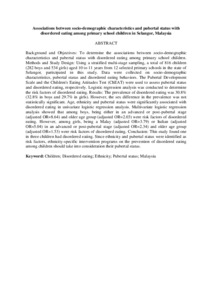Citation
Lin, Siew Chong and Yit, Siew Chin and Wan, Ying Gan and Mohd Nasir, Mohd Taib
(2017)
Associations between socio-demographic characteristics and pubertal status with disordered eating among primary school children in Selangor, Malaysia.
Asia Pacific Journal of Clinical Nutrition, 26 (2).
pp. 326-333.
ISSN 0964-7058, ESSN: 1440-6047
Abstract
Background and Objectives:To determine the associations between socio-demographic characteristics and pubertal status with disordered eating among primary school children. Methods and Study Design:Using a stratified multi-stage sampling, a total of 816 children (282 boys and 534 girls) aged 10 to 11 years from 12 selected primary schools in the state of Selangor, participated in this study. Data were collected on socio-demographic characteristics, pubertal status and disordered eating behaviors. The Pubertal Development Scale and the Children's Eating Attitudes Test (ChEAT) were used to assess pubertal status and disordered eating, respectively. Logistic regression analysis was conducted to determine the risk factors of disordered eating. Results:The prevalence of disordered eating was 30.8% (32.8% in boys and 29.7% in girls). However, the sex difference in the prevalence was not statistically significant. Age, ethnicity and pubertal status were significantly associated with disordered eating in univariate logistic regression analysis. Multivariate logistic regression analysis showed that among boys, being either in an advanced or post-pubertal stage (adjusted OR=8.64) and older age group (adjusted OR=2.03) were risk factors of disordered eating. However, among girls, being a Malay (adjusted OR=3.79) or Indian (adjusted OR=5.04) in an advanced or post-pubertal stage (adjusted OR=2.34) and older age group (adjusted OR=1.53) were risk factors of disordered eating. Conclusion:This study found one in three children had disordered eating. Since ethnicity and pubertal status were identified as risk factors, ethnicity-specific intervention programs on the prevention of disordered eating among children should take into consideration their pubertal status.
Download File
![[img]](http://psasir.upm.edu.my/60962/1.hassmallThumbnailVersion/Associations%20between%20socio-demographic%20characteristics%20and%20pubertal%20status%20with%20disordered%20eating%20among%20primary%20school%20children%20in%20Selangor%2C%20Malaysia.pdf)  Preview |
|
Text (Abstract)
Associations between socio-demographic characteristics and pubertal status with disordered eating among primary school children in Selangor, Malaysia.pdf
Download (6kB)
| Preview
|
|
Additional Metadata
Actions (login required)
 |
View Item |

